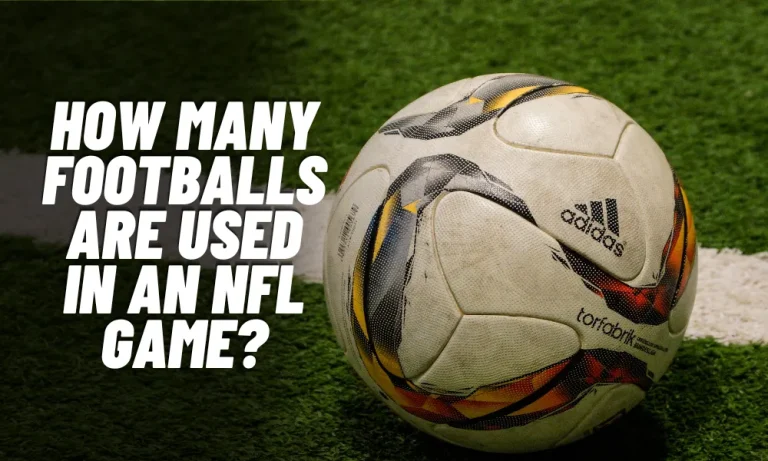What is a Pick Play in College Football?
Are you an avid fan of college football? If so, then you know that behind the thrilling touchdowns and impressive plays, there’s an intricate world of strategy and tactics at play. Today, we’re diving into one essential offensive maneuver that has been making waves on the field – the pick play. So, what exactly is a pick play in college football, and why is it so significant?
In simple terms, a pick play is a strategic offensive maneuver used to create space for receivers. It involves one receiver intentionally obstructing a defender, allowing another receiver to get open and receive a pass. This clever tactic has gained immense popularity in college football due to its ability to outsmart defenses and lead to successful plays. By understanding the dynamics of pick plays, you can gain valuable insights into the game and appreciate the strategic brilliance behind each play.
What is a Pick Play?
A pick play in college football is a crucial offensive tactic used to create space for receivers and gain an advantage over the defense. It involves one receiver intentionally obstructing a defender, allowing another receiver to get open and receive a pass. Picture this: I’m a wide receiver running my route, and just as I’m about to cut, my teammate sets a pick on the defender who is covering me. This pick creates a momentary obstacle for the defender, allowing me to break free and receive the pass.
The primary objective of a pick play is to create confusion and miscommunication among the defenders, allowing the offensive team to exploit gaps in the defense and gain yards. It relies on precise timing, coordination, and execution to be successful. When executed correctly, a pick play can completely change the dynamics of a play, opening up passing lanes, and creating scoring opportunities. It’s like a clever trick that offensive teams use to outsmart their opponents and gain an advantage on the field.
However, it’s important to note that there are rules and limitations regarding pick plays. While offensive players are allowed to create space for their teammates, they must do so within the boundaries of fair play. Offensive pass interference can occur if the pick is too aggressive or the receiver initiates contact with the defender beyond what is considered legal. So, a well-executed pick play requires finesse and careful positioning to avoid penalties and ensure its effectiveness.
The Mechanics of a Pick Play
Understanding the mechanics of a pick play is essential to grasp how this offensive tactic unfolds on the field in college football. Imagine this scenario: I’m a wide receiver lined up on one side of the formation, and my teammate, another receiver, is lined up on the opposite side. As the play begins, I start running my route towards the middle of the field, while my teammate moves towards the sideline. Just as I’m about to make my cut, my teammate strategically positions himself to block the defender covering me, creating a pick.
Timing is everything when it comes to executing a successful pick play. My teammate needs to time his movement precisely to create the pick at the right moment. If he sets the pick too early, the defender can easily avoid it and stay with me in coverage. On the other hand, if he sets it too late, I might need more time to break free and receive the pass. It’s a delicate balance that requires synchronization and understanding between the offensive players.
To execute a pick play effectively, communication is key. The quarterback must read the defense and recognize the opportunity to call for a pick play. The receivers need to understand their roles and be aware of the timing and positioning required. Additionally, the offensive line plays a crucial role in protecting the quarterback and giving the play enough time to develop. When all these elements align, a pick play can be a game-changing maneuver that results in big gains for the offense.
The Legality of Pick Plays
Understanding the legality of pick plays is crucial to ensure fair play in college football. While pick plays can be an effective offensive tactic, they must be executed within the boundaries of the rules. Offensive pass interference can occur if the pick is too aggressive or the receiver initiates contact with the defender beyond what is considered legal.
In a legal pick play, the offensive player must make an effort to avoid excessive contact with the defender. They cannot simply run into the defender or forcefully block them. Instead, they must position themselves strategically to create a natural obstacle for the defender, without impeding their ability to cover other offensive players.
It’s important to note that there is a fine line between a legal pick play and offensive pass interference. The officials closely monitor the execution of pick plays to ensure fair play. If the offensive player is deemed to have violated the rules by impeding the defender or initiating contact beyond what is allowed, a penalty for offensive pass interference may be called. Therefore, offensive players must understand the rules and execute pick plays with finesse and precision.
Common Variations of Pick Plays
In college football, pick plays come in various forms and variations, each designed to confuse the defense and create opportunities for the offense. Let’s explore some common variations:
1. Rub Routes: A rub route is a pick play where two receivers run routes that intersect or “rub” against each other. One receiver acts as a blocker, impeding the defender’s progress, while the other receiver uses the pick to break free and receive the pass.
2. Stacked Formations: Stacked formations involve aligning two or more receivers close together before the snap. This formation can create confusion for the defense as they try to navigate through the traffic created by the stacked receivers, allowing for quick passes and potential pick opportunities.
3. Wheel Routes: A wheel route is a pick play that involves a running back or tight end running a route toward the sideline while a receiver sets a pick on the defender covering the running back or tight end. This variation can catch the defense off guard and create open space for the receiver or running back.
These are just a few examples of the common variations of pick plays in college football. Each variation aims to exploit weaknesses in the defense and create favorable matchups for the offense. Teams need to practice these variations diligently to ensure proper execution and avoid penalties.
Defending Against Pick Plays
As a defender in college football, it’s crucial to have effective strategies to counter-pick plays and prevent the offense from gaining an advantage. Here are some key techniques to defend against pick plays:
1. Communication and Recognition: Communication is vital in defending against pick plays. My teammates and I must communicate effectively to identify potential pick situations and adjust our coverage accordingly. Recognizing the offensive formation and understanding the routes being run can help us anticipate pick plays and react swiftly.
2. Maintaining Proper Positioning: To defend against pick plays, it’s essential to maintain proper positioning and leverage. I need to anticipate the pick and position myself to avoid being blocked or impeded. By maintaining a good angle and staying disciplined with my coverage responsibilities, I can reduce the impact of pick plays.
3. Physicality and Timing: When defending against pick plays, physicality and timing are key. I must be able to navigate through traffic and fight through potential picks without losing my coverage. By using my hands to shed blockers and maintaining my timing, I can disrupt the offense’s execution and minimize the effectiveness of pick plays.
Defending against pick plays requires a combination of communication, positioning, and physicality. By understanding the offensive tendencies and executing these defensive techniques, my teammates and I can neutralize the impact of pick plays and maintain strong coverage on the field.
Impact and Influence of Pick Plays on the Game
In college football, pick plays have a significant impact on the game, influencing the outcome of plays and potentially shifting the momentum in favor of the offense. Here are some ways pick plays can influence the game:
1. Creating Separation: Pick plays are designed to create separation between receivers and defenders. When executed effectively, they can free up a receiver by obstructing the defender’s path or creating confusion in coverage. This separation allows the receiver to have a better chance of catching the ball and gaining yards after the catch.
2. Exploiting Mismatches: Pick plays often aim to exploit mismatches in coverage or individual matchups. By strategically setting picks, offenses can force defenders to switch assignments or create situations where a slower defender is matched up against a faster receiver. This can lead to big gains and scoring opportunities for the offense.
3. Confusing Defenses: Pick plays can confuse and disrupt the coordination of the defense. The subtle movements and crossing routes can make it challenging for defenders to maintain their coverage responsibilities. This confusion can lead to breakdowns in coverage and open passing lanes for the offense to exploit.
The impact and influence of pick plays on the game cannot be underestimated. They can change the dynamic of a drive, swing momentum, and create scoring opportunities for the offense. Defenses must be well-prepared and disciplined to counter the influence of pick plays and prevent them from becoming a game-changer.
FAQ’s
1. What is a pick play in college football?
A pick play is an offensive strategy where one or more receivers purposely block or impede defenders to create separation for another receiver to catch a pass.
2. Are pick plays legal in college football?
Yes, pick plays are legal as long as they are executed within the rules, without offensive pass interference or illegal blocking.
3. Can the defense defend against pick plays?
Yes, the defense can defend against pick plays by communicating, maintaining proper positioning, and using physicality to shed blockers and disrupt the offense’s execution.
4. How can pick plays impact the game?
Pick plays can impact the game by creating separation between receivers and defenders, exploiting mismatches, and confusing the defense, leading to scoring opportunities for the offense.
5. Are pick plays commonly used in college football?
Yes, pick plays are commonly used in college football due to their effectiveness in creating favorable matchups and gaining an advantage in the passing game.
Conclusion
In conclusion, understanding what a pick play is in college football is crucial for both offensive and defensive players. It’s not just about the execution of the play, but also about recognizing and countering it effectively. By comprehending the mechanics, legality, and variations of pick plays, offensive teams can exploit defensive weaknesses, while defenses can develop strategies to neutralize their impact.
However, it’s important to acknowledge the ongoing debate surrounding the use of pick plays in college football. The line between a legal pick play and offensive pass interference can sometimes be blurry, leading to controversy and discussions about fair play. As the game evolves, so will the tactics and strategies employed, and players, coaches, and fans must stay informed and adapt accordingly.
So, the next time you watch a college football game and witness a receiver break free for a crucial catch, remember the intricate role that pick plays in creating those opportunities. They are not just random occurrences but calculated maneuvers that can make all the difference on the field. Keep an eye out for these strategic moves and gain a deeper appreciation for the game within the game.


